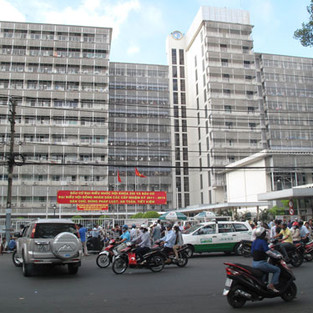Contact Care of Asia for immediate assistance in Vietnam.
Demographic changes, rise in disposable income, and a steady economic growth has led to a growing demand for healthcare services in Vietnam. In 2017, healthcare expenditure accounted for 7.5 percent of the GDP and between 2017 and 2021 it is predicted to grow at a compound annual growth rate (CAGR) of around 12.5 percent.
Overcrowding, shortage of medical staff, and obsolete equipment for surgery and intensive care units are the major challenges in the healthcare sector in Vietnam. These issues have forced Vietnamese people to travel abroad for medical treatment, with overseas annual spending rising to US$ 2 billion. This further highlights the opportunities in the industry in areas such as healthcare services, pharmaceuticals, and medical devices.
Hospital system
Vietnam has a decentralized system where provinces, districts and communes are given autonomy to implement their own healthcare policies. The organizational structure of the hospital or healthcare system in Vietnam is divided into four groups.
Central level – The Ministry of Health (MoH) is responsible for the healthcare sector for the government and manages several institutions including hospitals, research institutions, and universities. Other ministries also run their own network of hospitals.Central-affiliated province/city – At a province or city level, there are several hospitals and medicals centres. In addition, they also have medical colleges offering medicine, nursing, and pharmacy programs.District – In the district-level, district health centres mostly offer medical and preventive services.Commune – Commune health stations focus on primary healthcare services at a commune-level. Care of Asia as a leading medical assistance company in Vietnam has been building a great relationship with a large network of medical facitlies through out the country and beyond.
Infrastructure
In Vietnam, there are more than 1,167 public hospitals and 191 private hospitals, The total number of hospital beds increased from 254,885 in 2016 to 286,690 in 2019. A report also showed that there are more than 30,000 private polyclinics, 87 small-sized maternity hospitals, 30 foreign-invested clinics, and 29 clinics with involvement of foreign doctors across the country.
Legal forms of operation
To meet the growing demand for healthcare services, foreign investments in the sector especially through M&As has witnessed rapid growth in Vietnam. Investors can invest in healthcare establishments, pharmaceuticals, medical devices, and medical training units. Foreign investments up to 100 percent are allowed in each of these sectors with certain conditions on the capital requirement.
Healthcare treatment
This form of business includes hospital, medical, and dental services. Homecare, nursing, and emergency evacuation services are subject to approval on a case-by-case basis. Capital investment for a hospital is US$ 20 million, while a polyclinic and specialized clinic would require an investment of US$ 2 million and US$ 200,000 respectively.
Pharmaceutical
Except for distribution, all activities such as manufacturing, trading, storage, and testing are allowed in this sector.
Medical Devices
Activities such as manufacturing, trading, and distribution are allowed in the medical device sector.
Medical training
Investors can set up a university or a vocational training unit for medical training and educational purposes. Capital requirement for a university is US$ 6,500 per student and a minimum of US$ 13 million. For vocational training and short-term training, the capital requirements are US$ 2,600 and US$ 900 per student respectively.
Investment opportunities also exist in public-private partnership (PPP) projects. Vietnamese government on a central and provincial level have deployed numerous investment models to meet the growing demand for healthcare services and attract capital in the form of PPP in areas such as construction and management of infrastructure facilities, medical equipment, and training.







Comments